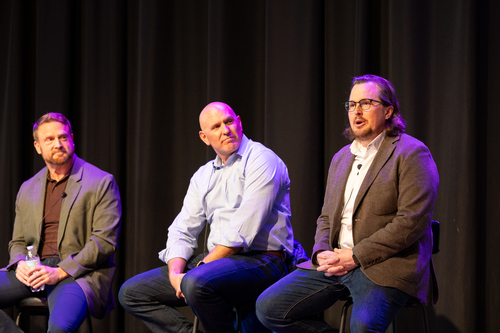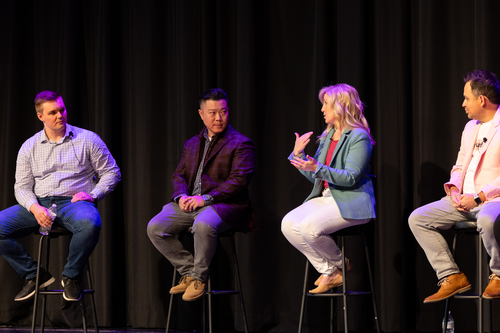Compassion isn’t a word traditionally associated with corporate culture, but how you treat your employees and react to their real situations–professionally and personally–could be the difference between finding the best talent and not. At From Day One’s January conference in Seattle, focused on “Listening to What Workers Want,” six executives talked about how high-performing workplaces can show compassion, too.
Henry Albrecht, CEO of the employee well-being platform Limeade, says his company tries to approach compassion through the lens of science. Data they gathered just as the pandemic hit showed half of employees reported manageable stress if they thought their company cared about them. If they didn’t, only 14% thought their stress was manageable. “If you know your company cares for you, you’re eight times more likely to feel included and twice as engaged and productive.”
Once Covid-19 hit, “it all got more visceral and real. We saw people at home who have kids with special needs, and they can’t take care of them the same way, and so they have to quit,” Albrecht said. The company determined its first task was to just show they care. “It was a brutally humbling experience for a lot of us. It’s not something you can just spout statistics about. It has to be felt,” he told panel moderator Enrique Cerna, a veteran Seattle TV news journalist.
The first way to show caring and empathy is to listen to employees. “That could be just seeing what’s going on behind them on a [Zoom] call. Empathy and care are sometimes viewed as over here, while business results are over there. I think we can prove that actually, the more care you show, the better the business results, and the better the retention. It’s been a hard journey, but you have to lift the weights to get stronger.”
At Fortive Corp., an industrial technology company, the culture in the past was “scorecard driven,” said Shannon Flynn, the VP of corporate HR. “The pandemic shifted that.” She says that the old focus was on what was working and what wasn’t. “The key thing for us was how do we connect to our employees in new ways, especially given that we can’t do things the way that we’ve normally done them? We can’t do Kaizen events where you would get a diverse group of people together to solve a problem over three days. How do we do that remotely?”
Like Fortive, when the pandemic hit, the Seattle Seahawks experienced a lot of constraints in the way they conducted business, said Karen Wilkins-Mickey, the team’s VP of diversity, equity and inclusion (DEI). “The Seahawks is all about team and camaraderie. How do you connect with your team? We had to figure out ways to use technology to connect in new ways.”
Wilkins-Mickey was particularly proud of how they used the necessity for change to try to amplify those voices that normally weren’t heard. “There are a lot of people operating the team, and this is about knowing those people in a different way. When you hear someone’s story, it connects with you. It has really driven empathy. We are looking now for ways to support employees in the way they want to be supported.”
When Sudden Strains Hit the Staff
In a state-run agency that often bears the brunt of public scrutiny and outbursts from customers, creating internal compassion became even more important. Michaela Doelman, the chief HR officer at the Washington State Employment Security Department, said that at the onset of the pandemic, the state saw unemployment go from about 4% to 30% overnight and had to serve that massive influx with half the employees they had at the start of the Great Recession years ago. Yet hiring happened quickly, and those 1,600 new staff had to onboard virtually. They needed education in complex and changing employment law, she said.
Compassion for customers and for staff was the first goal, after health and safety. “We leaned into the values of building meaningful relationships,” said Doelman. As staff became burned out, managers tried to help them “reorient to the moments of celebration and find new ways to lift up and show they are valued.”
Blueboard, an employee-recognition platform, kept its mission in mind when showing compassion for their own workers. Morgan Chaney, the senior director of marketing, says that the company’s 200 staff members are all working remotely, and scattered around the world. “One of our company values is building meaningful relationships.” It has made her think about creating spaces where people can “have human-to-human conversation.” That might be something as small as taking time to connect before or after Zoom meetings, or as large as changing they way they measure performance.
Blueboard’s role in creating recognition programs has not only helped clients, but helped Blueboard itself to “reorient what the moments of celebration are. And at this point, it’s not just about the work you’ve done. It’s about displaying company values, being a culture champion, and really think about new ways to lift everyone up and show people that they are seen and valued–even if it is different from what we celebrated before,” Chaney said.
Compassion’s Role in Retention and Attrition
Zillow Group’s director of recruiting, Taryn Little, joined the company in the midst of the “great reshuffle,” as she called it. Among the things that inspired her to joint the company was caring leadership and quarterly surveys that look at retention and attrition rates. “We talk about them openly,” she said. “We do training on crucial conversations.” It’s not just about results, but about being more flexible with staff who are at home, dealing with a myriad of issues. “As a leader, I have been more flexible and adaptable to people’s schedules. And I just have to understand that there’s a lot that we’re all trying to balance.”
Mid-pandemic, the nation also had to deal with the racial reckoning that was the result of highly publicized killings of Black people by police, including George Floyd and Breonna Taylor. “I went through the week of George Floyd with a pit in my stomach, but I still had to keep going to meetings,” said Wilkins-Mickey, who is Black. “I stopped one of those meetings, and as the only woman of color, I told them what I was feeling. If I can’t trust who I’m around to tell my truth, I shouldn’t be there. I told them that I was hurting, and that there were others who don’t feel they have a seat at the table or don’t feel safe enough to speak.”
Wilkins-Mickey said a company has to create a space where staff feel safe enough to speak their truth, but also must do more than just be reactive. “When George Floyd happened, every organization went straight to action, with statements and programs. The thing that was hard was that I have been Black this whole time. This is my whole world and you’re only now noticing. I’ve been pushing this ball up hill a long time and you only just now see me? I didn’t say that, but I made sure to take advantage of the opportunity so that we move beyond just responding to a moment in time.”
Currently, the Seahawks have a program called “Hear Our Story,” designed to amplify the voices of those who are not normally heard. The idea of sharing personal stories is also something Blueboard has adopted, aiming to tell stories of the staff, from intern to C-suite. “In honor of Martin Luther King Jr., we had a moment where a variety of employees were able to share their personal stories, which really helped to ground people in what it is like to live those experiences,” said Chaney. One employee told of picking up a package–something they normally did in the course of their job–when a bystander started filming them, and followed them into the office, “which was very scary. As a white woman, it informed me about what they go through every day. We need to be advocating, we need to be aware, and we need to hear firsthand from employees who live and breathe this daily.”
Using Data to Look at the Real Story
Stories aren’t enough for the Employment Security Department in Washington. It was important to become an avowedly antiracist organization, said Doelman. “The system was created in a discriminatory way. It didn’t allow agricultural workers to apply [for unemployment benefits], and disproportionately causes harm to some communities. They want to question where the barriers are, where bias shows up, and data that details who is–and who isn’t–getting access to promotions or certain jobs,” said Doelman. “We can’t just tell stories. We have to look at data to make actionable change.”
Limeade is one of the few companies that has data showing equal numbers of men and women in tech positions, said Albrecht. To achieve that kind of success requires gathering data, looking at it, publishing it, and creating goals related to it. Goals related to diversity should be treated the same as goals related to sales, or marketing, or quality, he said. “Check in every quarter and determine: did we get better, or did we get worse?”
In developing data sets and creating surveys, one also has to ask pertinent questions that surround issues of race, said Chaney. “Do you ask questions about feelings of belonging or safety?” Albrecht said he agreed: “We had this product that measured belonging that was a super-unsuccessful commercial project. But when we bundled that into our well-being survey, we found the statistics correlated. You can’t have well-being if you don’t have some feeling of safety.” And those who don’t feel safe are much more likely to leave a company.
Like other companies, the Seahawks had listening sessions and conducted surveys. “The feedback was that everyone was fine, but we know they weren’t,” said Wilkins-Mickey. “We tried to demonstrate and earn trust over time. If they say we are failing, we have to believe them. We are getting complaints now from people who have been here for 15 or 20 years. Now they believe we will invest in solving their problems.” Those comments come from disproportionately underrepresented marginalized communities. “We are getting information so we can make changes.”
“I don’t think people are honest in surveys,” said Flynn. “They worry that something will be traceable back to them. So you have to create safety so that people feel comfortable having real conversations.” She has spent time asking specific questions of people, and also having more general conversations. “I wanted them to know I really care about what they are feeling, and if there are common themes, we can address them.”
Up and Down the Hierarchy
Albrecht said it’s important for there to be top-down evidence of care. At the top, you need to ask whether leadership shows itself to be empathetic. “Do you measure metrics of transparency, diversity, equity, and inclusion?”
On the bottom of the hierarchy are individual moments of care that come from events like covering for team members when they are having family crises. And in the middle are the managers, who should be “inspiring middle managers who can connect with the purpose of the company and the true mission, inspire and make people feel included and valued, rather than just trying to get promoted,” Albrecht said.
The other items on the pyramid are little things you can do daily, he said. “Maybe it’s just sharing your pronouns, or one thing I’m proud of is that on the stock exchange [legal documents] where the default word is chairman, and we changed it to chair. No one had done that before. It’s a pretty small thing, but if a thousand of those things happen, maybe something good will follow.”
Lisa Jaffe is a freelance writer who lives in Seattle with her son and a very needy rescue dog named Ellie Bee. She enjoys reading, long walks on the beach, and trying to get better at ceramics.




